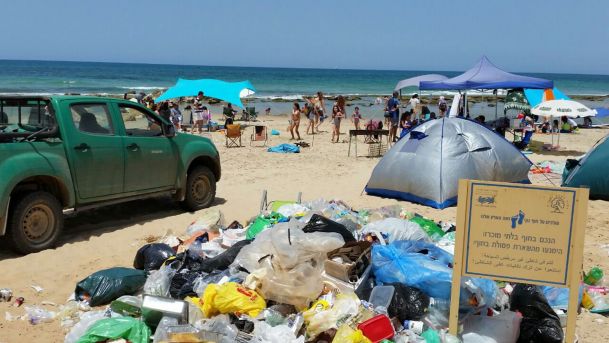ISRAEL’S COAST IS POLLUTED PART OF MEDITERRAN
Plastic accounts for 90 percent of local garbage in the sea, posing a danger to marine life. Much of the prodigious amount of garbage on Israel’s beaches ends up in the sea, making our region of the Mediterranean Sea one of the most polluted, a new study shows. The most common polluter is plastic, with the concentration of its particles in the water 10 times the average in the western Mediterranean.

Author: Zfrir Rinat
Photo: www.haaretz.com
Plastic accounts for 90 percent of local garbage in the sea, posing a danger to marine life. Much of the prodigious amount of garbage on Israel’s beaches ends up in the sea, making our region of the Mediterranean Sea one of the most polluted, a new study shows. The most common polluter is plastic, with the concentration of its particles in the water 10 times the average in the western Mediterranean.
People who frequent the beaches for recreation are the main culprits behind the discarded garbage, according to Galia Pasternak, a Ph.D. candidate at the University of Haifa. Her dissertation focuses on solid waste on unofficial beaches in Israel, which she is studying with the assistance of the Israeli NGO EcoOcean.
Pasternak, who is on the staff of the Environmental Protection Ministry’s marine and beaches branch, studied the quantities and components of the garbage on eight, 100-meter-long sections of beach. She also compared them with other places in the world, and measured the amounts of garbage floating on the water surface.
The results of her research show that the amount of garbage on Israel’s beaches is actually low compared to other countries – 0.11 objects per square meter, compared to 0.8 – 2 objects per square meter in many other countries. But this is not due to the average Israeli beach-goer’s high level of cleanliness, she says. Rather, it the result of a government program to clean up Israel’s non-official beaches.
As for the garbage itself, some of it floats up on the currents from the Gaza Strip and Egypt, but according to Pasternak’s calculations, at least 58 percent is local and originates on land. And of that amount – 90 percent is plastic. The remains of cigarettes and various food packaging account for the rest.
One of the interesting findings is the apparent impact of recycling laws on the components of the garbage. Pasternak found a large number of big plastic bags – three times the global average and twice the amount elsewhere in the Mediterranean. She says that her findings show that elsewhere in the world, where there is legislation limiting the use of big plastic bags, the quantities are lower. Two months ago the Knesset passed a law mandating fees for plastic bags, which should lead to a decline in use.
Pasternak — who conducted her research under the supervision of advisers Prof. Ehud Spanier of the University of Haifa and Dr. Dov Zviely of Ruppin Academic Center — found the percentage of plastic bottles and metal soft drink containers to be a third of the world average. She attributes this figure to the positive impact of the deposit and return policy on such containers.
Plastic is considered one of the greatest threats to the marine environment because over time it deteriorates into tiny “microplastic” particles that cannot be treated. Another doctoral candidate at the University of Haifa, Noam Van der Hal, examined the potential toxicity of these particles and his research shows that they are absorbed into the bodies of marine animals and could harm them.
Van der Hal, whose dissertation is advised by Dr. Dror Angel of the University of Haifa, collected the microplastic in special nets at 17 sampling points along the beaches. He also took soil samples at a depth of 10 meters at eight different sites to determine the concentration of the particles and other contaminants that might adhere to the plastic.
He found that the concentration of such particles and contaminants attached to them are 10 times higher on average than elsewhere in the western Mediterranean. In one place, the highest quantity of microplastic in the world was measured. However, Van der Hal says his research does not show what percentage of the plastic pollutants came from Israel’s beaches and how much arrived on sea currents.
Arik Rosenblum, director of EcoOcean, which is also assisting in the funding of Van der Hal’s research says the findings “inculcate the need for institutional and personal enlistment toward cleanliness and protection of the beaches.”




